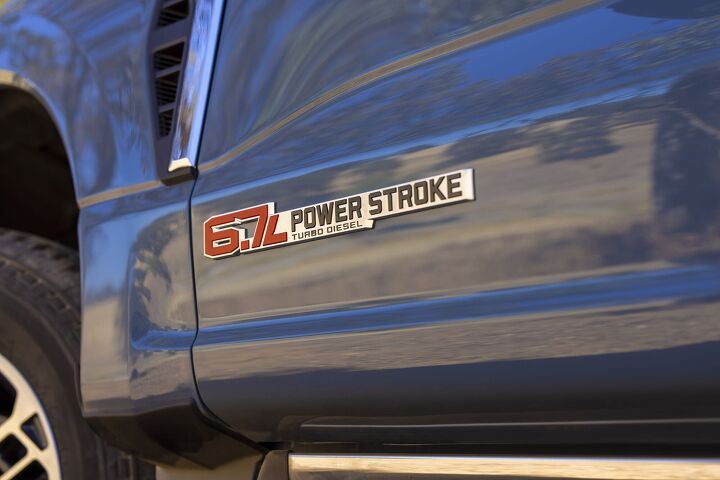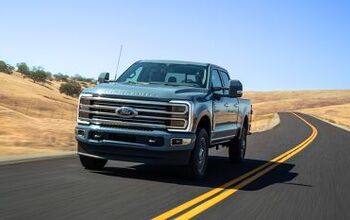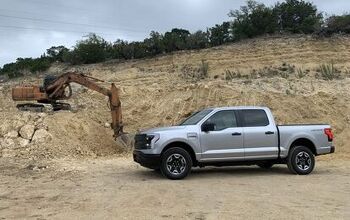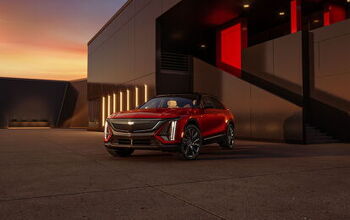First Drive: 2023 Ford Super Duty Lineup

While Ford has been shipping all trims of its all-new 2023 Super Duty pickup line to customers since May, production issues have delayed things and you’ll be hard-pressed to find someone that’s actually driven one. Fortunately, the Blue Oval invited us to take a gander at the new trucks at the Ford Michigan Proving Grounds earlier this month.
As first impressions go, the Super Duty led off with a firm handshake and proved that it can be slotted into a myriad of roles. Ford offered up an impressive resume and a sound business plan and allowed us to beat on a few examples to prove its rigs were the correct vehicle for any job.
The company is exceptionally proud of its dominant market share for construction, mining, utility, and emergency response vehicles. But it’s clearly aware that it’s not going to maintain that position by resting on its laurels and is pulling out all the stops to remain strong in the commercial market.
(Full Disclosure: Ford invited me out to the 3,880 acres that make up the Michigan Proving Grounds in Romeo. While the manufacturer did not need to provide travel accommodations or lodging, I did enjoy the lunch they served during testing.)
All-new for the 2023 model year, Ford’s Super Duty pickup spans the gamut — offering humble commercial variants with a regular cab, luxurious crew-cab models, and just about everything in between. Trims should be familiar to most, with Ford offering the XL, XLT, Lariat, King Ranch, Platinum, and Limited.
Powertrain options have already been leaked and come with the same 10-speed TorqShift automatic found on the previous generation. Four-wheel drive is standard on everything from the XLT and up.
Motors have been tweaked to deliver better performance than their predecessors. The 6.8-liter gasoline engine (405 horsepower and 455 lb-ft of torque) has been tuned to deliver more low-end pulling power and supplants the 6.2-liter V8 as the default engine. Meanwhile, the 7.3-liter V8 (430 hp and 485 lb-ft) is said to have been issued improved air intake.
Even more attention was given to the diesel engines. The 6.7-liter PowerStroke V8 (475 hp and 1,050 lb-ft) is now supposed to be capable of longer intervals between oil changes, with Ford believing this will be a boon to fleet operators. The High-Output variant (500 hp and 1,200 lb-ft) was given some unique tuning to help deliver more power, along with a new water-jacketed turbine housing to keep the turbo cooler and cast stainless steel exhaust headers for added durability.
When properly configured as an F-450 Super Duty with the Gooseneck Tow Package and High-Output 6.7-liter diesel engine, that makes for a maximum towing capacity of 40,000 pounds. Though even the F-250 can drag around 20,000 pounds if you option one of the diesel motors. You’ll lose a few thousand pounds if you stick with a pickup burning gasoline. But it’s pretty difficult to configure any Super Duty to handle less than 15,000 pounds of towing. Max payload is likewise impressive at 8,000 pounds on the F-350 with the Heavy-Duty Payload Package.
Blue Oval allowed us to do a little testing on a section of the roughly 100 miles of road located at the facility. While yours truly doesn’t do much serious towing, every Super Duty seemed quite composed when towing at the limit and with much less drama than the old beaters I’m used to piloting. Though I spent the majority of my time lugging around 20,000-pound trailers on trucks set up to handle them and spent no time in the F-450.
Despite my being eager to take the Super Duty off-road, the tech Ford has dedicated to towing alone is genuinely impressive. A lot of thought was given to how to make the truck commercially viable, with the brand going so far as to come up with solutions to make one-man operations more feasible.
Pro Trailer Hitch Assist effectively backs up the truck for you, properly aligning the ball hitch with the trailer without your needing a spotter. Onboard Scales with Smart Hitch likewise provides operators with help estimate trailer tongue weight distribution by using the right-height sensors. While this can be achieved via the Sync 4.0 infotainment system, there’s also a lightbar in the taillights that shows you when you’ve hit the sweet spot. Towing setup is relatively easy, with the Blue Oval offering the ability to have the pickup run through all the lights automatically so the driver can check them.
Ford even added another camera and some sensors to the top of the Super Duty’s tailgate to ensure the experience of reversing the pickup remains the same when the bed has been fully loaded and left open.
While some of the above isn’t new, all of it is extremely handy if you’re using your pickup for tough jobs. It's all very clever and designed to help encourage fleet managers to stick with Ford, as two-person jobs are now easily achievable by a solo operator. But even retail customers can appreciate the inclusions, especially if they happen to have a particularly shrill and unhelpful spouse.
Ford had more tricks up its sleeve. With upgrades to the Super Duty focused on tech, Ford Pro is offering a new software suite tailored specifically for its commercial and fleet customers. The brand’s Upfit Integration now allows for seamless communication between the trucks and any utility items that have been installed. In our demo, the company focused on cranes and snowplows. But upfitters that have partnered with Ford should be able to install highly customizable controls for whatever gear is required and then integrate the applicable controls directly into the infotainment system.
Modified pickups can be programmed to behave similarly and without the need to add loads of external switchgear. While that’s probably not going to make the folks at JC Whitney happy, it does make for cleaner cabins and keeps Ford in the loop after vehicles have been modified. While the company said it wasn’t scraping any data from the upgraded Ford Pro service just yet, data acquisition is forthcoming — providing the automaker with a wealth of information about its commercial products.
I’ve certainly got mixed opinions about connected vehicles. But this is a smart play by Ford and something other automakers are definitely going to be envious over. My only gripe here is that the company really should open it up to customers. The interface seems easy enough to use and basically requires the installation of a $400 module (standard on chassis cabs) with a general understanding of the software. Being a certified upfitting partner with Ford Pro seems unnecessary and basically means smaller businesses won’t have access.
Ford also let us play around with the Super Duty Tremor on a few portions of its off-road development course, noting that some mining and forestry vehicles never spend a single day on pavement. While your author is neither the resident truck aficionado, nor an off-roading guru, they’re absolutely capable here thanks to their upgraded suspension and extra-gnarly tires.
I spent most of my time in the Tremor King Ranch, which massaged my back and butt while happily going over some brutal terrain. But Ford also offers lower trim variants that seem equally at home wading through mud and scrambling over rocks. While they’re still massive vehicles, Trail Turn Assist makes right corners possible without needing to reverse and was a lot of fun to test near its 12 mph limit. The Tremor’s off-road camera options were also handy and easy to use over bumps, as there has been a dedicated camera button added to the dashboard.
Obviously, one’s experience in the Super Duty is highly dependent upon how it’s been optioned. This is apparent whether you’re standing outside the vehicle or planted in the driver’s seat. All lower-trim models come with an 8-inch infotainment screen, whereas Lariat and above feature a 12-inch unit. Customizable digital gauges are standard, as is a customizable head-up display that was one of the best I’ve come across.
While the overall changes to the interior leave it looking a bit more basic, mimicking what we’ve seen with the F-150, the layout is fine, absolutely functional, and can be decked out as you climb the trim ladder. Meanwhile, the exterior just improves upon the look of the older F-Series and offers a more useful truck bed — one again following what we’ve seen with other Ford pickups.
On-road impressions were good, though I did not spend much time on the expressway. If you don’t mind a vehicle that handles like a big truck (engineering has its limitations) then you can have an incredibly comfortable pickup that doubles as a working rig. Pot-hole-riddled streets are a non-issue for the Super Duty and higher trims are effectively luxury vehicles. Parking likewise isn’t bad and is made easier thanks to electronic helpers. City dwellers should probably look elsewhere. But those spending most of their time in rural environments, small towns, construction sites, and the suburbs could easily make the big truck their daily driver.
Ford also addressed the elephant in the room, saying that it was working tirelessly to address concerns about quality control. It’ll be a while before we see if those efforts have paid off. But the new Super Duty is probably the smoothest heavy-duty pickup I’ve ever been inside of. Bigger trucks are normally a little rough around the edges vs their smaller counterparts. But the Super Duty seemed exceptionally polished and largely indistinguishable from an F-150 until you need to flex any one of its giant motors.
When I’m thinking about what to buy, something like the Super Duty is typically at the very bottom of my list. However, if you gave me a wad of cash and the option of buying a Mercedes-Benz E 450 or well-appointed F-250 Lariat that costs about the same, I would have to mull it over for longer than I would have guessed before driving Ford’s new pickups.
Though these are not cheap trucks. A bare-bones F-250 XL with rear-wheel drive starts at $45,865, comes with a myriad of options, and can gain another $10,000 if you select the tamer version of the 6.7-liter diesel V8. Meanwhile, the F-450 Limited starts above $100,000 and has plenty of options to add, despite already being equipped with the fanciest gear. The 2023 Ford Super Duty certainly won’t be the vehicle for everyone. But commercial clients are probably going to remain loyal and interested retail customers can tailor it to their preferences if they’re willing to spend the dough.
Throw any questions you have in the comments and look for a more comprehensive assessment of the individual trims as they're shipped our way for full reviews.
[Images: Ford, © 2023 Matt Posky/TTAC]
Become a TTAC insider. Get the latest news, features, TTAC takes, and everything else that gets to the truth about cars first by subscribing to our newsletter.

A staunch consumer advocate tracking industry trends and regulation. Before joining TTAC, Matt spent a decade working for marketing and research firms based in NYC. Clients included several of the world’s largest automakers, global tire brands, and aftermarket part suppliers. Dissatisfied with the corporate world and resentful of having to wear suits everyday, he pivoted to writing about cars. Since then, that man has become an ardent supporter of the right-to-repair movement, been interviewed on the auto industry by national radio broadcasts, driven more rental cars than anyone ever should, participated in amateur rallying events, and received the requisite minimum training as sanctioned by the SCCA. Handy with a wrench, Matt grew up surrounded by Detroit auto workers and managed to get a pizza delivery job before he was legally eligible. He later found himself driving box trucks through Manhattan, guaranteeing future sympathy for actual truckers. He continues to conduct research pertaining to the automotive sector as an independent contractor and has since moved back to his native Michigan, closer to where the cars are born. A contrarian, Matt claims to prefer understeer — stating that front and all-wheel drive vehicles cater best to his driving style.
More by Matt Posky
Latest Car Reviews
Read moreLatest Product Reviews
Read moreRecent Comments
- NJRide A question and a point:1) What were hybrids at compared to last year? And plug in bs a regular hybrid?2) How can state governments like mine possibly think 40 percent of sales will be electric in 3 years?
- Steve S. Steve was a car guy. In his younger years he owned a couple of European cars that drained his bank account but looked great and were fun to drive while doing it. This was not a problem when he was working at a good paying job at an aerospace company that supplied the likes of Boeing and Lockheed-Martin, but after he was laid off he had to work a number of crummy temp jobs in order to keep paying the rent, and after his high-mileage BMW was totaled in an accident, he took the insurance payout and decided to get something a little less high maintenance. But what to get? A Volkswagen? Maybe a Volvo? No, he knew that the parts for those were just as expensive and they had the same reputation for spending a lot of time in the shop as any other European make. Steve was sick and tired of driving down that road."Just give me four wheels and a seat," said Steve to himself. "I'll buy something cooler later when my work situation improves".His insurance company was about to stop paying for the rental car he was driving, so he had to make a decision in a hurry. He was not really a fan of domestics but he knew that they were generally reliable and were cheap to fix when they did break, so he decided to go to the nearest dealership and throw a dart at something.On the lot was a two year old Pontiac Sunfire. It had 38,000 miles on it and was clean inside and out. It looked reasonably sporty, and Steve knew that GM had been producing the J-car for so long that they pretty much worked the bugs out of it. After taking a test drive and deciding that the Ecotec engine made adequate power he made a deal. The insurance check paid for about half of it, and he financed the rest at a decent rate which he paid off within a year.Steve's luck took a turn for the better when he was offered a job working for the federal government. It had been months since he went on the government jobs website and threw darts at job listings, so he was surprised at the offer. It was far from his dream job, and it didn't pay a lot, but it was stable and had good benefits. It was the "four wheels and a seat" of jobs. "I can do this temporarily while I find a better job", he told himself.But the year 2007 saw the worst economic crash since the Great Depression. Millions of people were losing their jobs, the housing market was in a free fall, people were declaring bankruptcy left and right, and the temporary job began to look more and more permanent. Steve didn't like his job, and he hated his supervisors, but he considered himself lucky that he was working when so many people were not. And the federal government didn't lay people off.So he settled in for the long haul. That meant keeping the Sunfire. He didn't enjoy it, but he didn't hate it either, and it did everything he asked of it without complaint.Eventually he found a way to tolerate his job too, and he built seniority while paying off his debts. There was a certain feeling of comfort and satisfaction of being debt-free, and he even began to build some savings, which was increasingly important for someone now in their forties.Another bit of luck came a few years later when Steve's landlord decided to sell the house Steve was renting, at the bottom of the housing market, and offered it to Steve for what he had in it. Steve's house was small and cramped, and he didn't really like it, but thanks to his savings and good credit he became a homeowner in an up and coming neighborhood.Fourteen years later Steve was still working that temporary job, still living in that cramped little house that he now hated, and still drove the Sunfire because it wouldn't die. For years now he dreamed of making a change, but then the pandemic happened and threw the economy and life in general into chaos. Steve weathered the pandemic, kept his job when millions of people were losing theirs, and sheltered in place in that crummy little house, with Netflix, HBO, and a dozen other streaming services keeping him company, and drove to and from work in the Sunfire because it was four wheels and a seat and that's all he needed for now.Steve's life was secure, but a kind of dullness had set in. He existed, but the fire went out; even when the pandemic ended and life returned to normal Steve's life went on as it had for years; an endless Groundhog Day of work, home, work, home. He never got his real-estate license or finished college and got his bachelor's, never got a better job, never used his passport to do some traveling in Europe. He lost interest in cars. "To think how much money I wasted on hot cars when I was younger", he said to himself. He never married and lost interest in dating. "No woman would want me anyway. I've gotten so dull and uninteresting that I even bore myself".Eventually the Sunfire began to give trouble. With 200,000 miles on the clock it was leaking oil, developing electrical gremlins, and wallow around on blown-out shocks. Steve wasn't hurting for money and thought about treating himself to a new car. "A BMW 3-series, maybe. Or maybe an Alfa Romeo Giulia!" He began to peruse the listings on Autotrader. "Maybe this is just what I need to pull out of this funk. Put a little fun back in my life. Yeah, and maybe go back to the gym, and who knows, start dating again and do some traveling while I'm still young enough to enjoy it!"Then his father passed away and left him a low-mileage Ford. Steve didn't like it or hate it, but it was four wheels and a seat, and that's all he needed right now."Is it too late to have a mid-life crisis?" Steve thought to himself. For what he needed more than that stable job, that house with an enviably small mortgage payment, and that reliable car was a good kick in the hindquarters. "What the hell am I afraid of? I should be afraid that things will never change!"But the depression was like a drug, a numbness that they call "dysthymia"; where you're neither here or there, alive or dead, happy or sad. It was a persistent overcast, a low ceiling that kept him grounded. The Sunfire sat in his driveway getting buried by the needles from his neighbor's overhanging pine trees which were planted right on the property line. "Those f---ing pine trees! That's another thing I hate about this damn house!" Eventually the Sunfire wouldn't start. "I don't blame you", he said to the car as he trudged past it to drive the Ford to another Groundhog Day at that miserable job.
- Yuda Cool. Cept we need oil and such products. Not just for fuel but other stuff as well. The world isn't exactly ready to move to wind and solar and whatever other bs, the technology simply isn't here yetNot to mention it's too friggin expensive, the equipment is still too niche and expensive as it stands
- Rna65689660 Picked up my wife’s 2024 Bronco Sport Bad Lands!
- Inside Looking Out Android too.

















































Comments
Join the conversation
There was a unicorn in those photos - a regular cab dually.
I own an IT company that builds wifi for RV parks/Marinas. I often load my HD truck with lots of IT gear, and tow a trailer to a job site. I think a lot of these tech features are nice for people working alone. I see it all the time with work campers having to arrive in a new city, hitch up a trailer at night and back their rig into a campsite without any assistance. That's where these tools help, also for folks who are recreational drivers who two 5-8x a year. Those who comment that trucks are getting ridiculously big. Yes, and no I agree. Yes, they are big for daily driving. No, not for towing and working. To a point the heavier/longer wheel base of the tow vehicle the more comfortable the towing experience. The problem with daily of an HD truck is a lot of people need them occasionally for their trailer but can't afford 2 vehciles so the HD truck is their daily commuter. Me I have the luxury of a personal vehicle and don't have to. These trucks suck in parking lots. But are unbeatable as tools to do a job, especially in construction sites without paved roads.